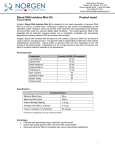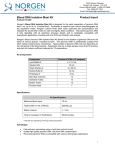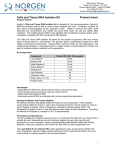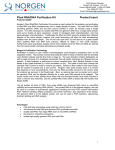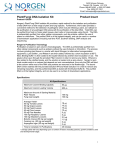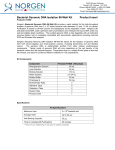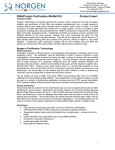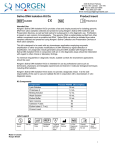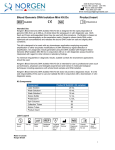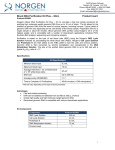Download 51400 - Protocol (20 prep)
Transcript
3430 Schmon Parkway Thorold, ON, Canada L2V 4Y6 Phone: 866-667-4362 (905) 227-8848 Fax: (905) 227-1061 Email: [email protected] Blood DNA Isolation Midi Kit Product Insert Product #51400 Norgen’s Blood DNA Isolation Midi Kit is designed for the rapid preparation of genomic DNA from 0.3 to 2 mL of whole blood. Purification is based on spin column chromatography as the separation matrix. Norgen’s column binds DNA under optimized salt concentrations and releases the bound DNA under low salt and slightly alkali conditions. The purified genomic DNA is fully digestible with all restriction enzymes tested, and is completely compatible with downstream applications including real-time PCR and southern blot analysis. Norgen’s Blood DNA Isolation Kit allows for the isolation of genomic DNA from the blood of various species, including humans. The genomic DNA is preferentially purified from other cellular proteinaceous components. Typical yields of genomic DNA will vary depending on the cell density of the blood sample. Preparation time for a single sample is less than 45 minutes, and each kit contains sufficient materials for 20 preparations. Kit Components Component Lysis Buffer B Solution WN Wash Solution A Elution Buffer B Proteinase K Midi Spin Columns Midi Collection Tubes Midi Elution Tubes Product Insert Product # 51400 (20 samples) 2 x 40 mL 55 mL 2 x 38 mL 30 mL 4.4 mL 20 20 20 1 Specifications Kit Specifications Blood Input 0.3-2 mL Column Binding Capacity > 100 g Average Yield 60 g* Time to Complete 10 Purifications 50-60 minutes * Yield will vary depending on the type of blood processed Advantages Fast and easy processing using a rapid spin-column format Isolate high quality genomic DNA, free from RNA contamination Recovered genomic DNA is compatible with various downstream applications 1 Storage Conditions and Product Stability All solutions should be kept tightly sealed and stored at room temperature. These reagents should remain stable for at least 1 year in their unopened containers. The kit contains a ready-touse Proteinase K solution, which is dissolved in a specially prepared storage buffer. The Proteinase K is stable for up to 1 year after delivery when stored at room temperature. To prolong the lifetime of Proteinase K, storage at 2–8°C is recommended. Precautions and Disclaimers This kit is designed for research purposes only. It is not intended for human or diagnostic use. Ensure that a suitable lab coat, disposable gloves and protective goggles are worn when working with chemicals. For more information, please consult the appropriate Material Safety Data Sheets (MSDSs). These are available as convenient PDF files online at www.norgenbiotek.com. The Lysis Buffer B and Solution WN contain guanidinium salts, and should be handled with care. Guanidinium salts form highly reactive compounds when combined with bleach, thus care must be taken to properly dispose of any of these solutions. Blood of all human and animal subjects is considered potentially infectious. All necessary precautions recommended by the appropriate authorities in the country of use should be taken when working with blood. Customer-Supplied Reagents and Equipment Variable speed swing bucket centrifuge that can reach 4500 x g (5000 rpm) and can accommodate 15 mL centrifuge tubes Micropipettors 96 - 100% ethanol 56°C waterbath or incubator 70ºC incubator Lysozyme (for blood containing Gram positive bacterial pathogens) º 37 C incubator (for blood containing Gram positive bacterial pathogens) Vortex Procedure All centrifugation steps are carried out in a swing bucket centrifuge that can reach 4500 x g (5000 rpm) and can accommodate 15 mL centrifuge tubes. Various speeds are required for different steps, so please check your centrifuge specifications to ensure that it is capable of the proper speeds. All centrifugation steps are performed at room temperature. The correct rpm can be calculated using the formula: RCF RPM = (1.118 x 10-5) (r) where RCF = required gravitational acceleration (relative centrifugal force in units of g); r = radius of the rotor in cm; and RPM = the number of revolutions per minute required to achieve the necessary g-force. 2 Flow Chart Procedure for Purifying Blood DNA using Norgen’s Blood DNA Isolation Midi Kit Obtain anticoagulated blood sample and transfer into a tube containing Proteinase K Add Lysis Buffer B. Vortex. Spin briefly. Incubate. SPIN (optional) Add Ethanol Bind to column SPIN Wash once with Solution WN. Wash twice with Wash Solution A Dry spin. SPIN Elute DNA with Elution Buffer B SPIN Pure Genomic DNA 3 Notes prior to use: Ensure that all solutions are at room temperature prior to use, and that no precipitates have formed. If necessary, warm the solutions and mix well until the solutions become clear again. A variable speed centrifuge should be used for maximum kit performance. If a variable speed centrifuge is not available a fixed speed centrifuge can be used, however reduced yields may be observed. For best results, the use of whole blood collected into tubes containing an anticoagulant is highly recommended. Both fresh and frozen anticoagulated blood may be used with this procedure. Ensure that frozen blood is thawed at room temperature prior to starting the protocol. Prepare a working concentration of the Solution WN by adding 73 mL of 96 - 100 % ethanol (provided by the user) to the supplied bottle containing the concentrated Solution WN. This will give a final volume of 128 mL. The label on the bottle has a box that may be checked to indicate that the ethanol has been added. Prepare a working concentration of the Wash Solution A by adding 90 mL of 96 - 100 % ethanol (provided by the user) to each of the supplied bottles containing the concentrated Wash Solution A. This will give a final volume of 128 mL. The label on the bottle has a box that may be checked to indicate that the ethanol has been added. Pre-heat Elution Solution B at 70ºC For blood containing Gram positive bacterial pathogens, prepare a 400 mg/mL stock solution (approximately 1.7 x 107 units/mL) of lysozyme as per supplier's instructions. Always vortex the Proteinase K before use. A. Isolation of DNA from 0.3 - 1 mL of Blood 1. Sample Preparation NOTE: For DNA isolation from blood containing Gram positive bacterial pathogens, please see Appendix A for Sample Preparation. a. b. c. Add 0.1 mL of Proteinase K (vortex the Proteinase K before use) to a 15 mL tube. Transfer 0.3 - 1 mL of blood sample to the tube containing Proteinase K. Add 1.5 mL of Lysis Buffer B to the blood and mix vigorously by shaking the tube for 10 seconds then vortex vigorously for 10 seconds. Note: During vortex, ensure that the contents are being mixed well. d. e. Briefly spin the tube to collect any drops of liquid from the inside of the lid. º Incubate at 56 C for 15 minutes, mixing once during incubation by vigorous shaking. Note: If any debris is present in the sample, centrifuge for 2 minutes at 4,500 x g (~5,000 RPM) to precipitate. Transfer the clean supernatant to a clean tube prior to the next step. f. g. Add 1.25 mL of 96-100% Ethanol to the sample and mix vigorously by shaking the tube for 10 seconds then vortex for 10 seconds. Briefly spin the tube to collect any drops of liquid from the inside of the lid. 2. Sample Binding to Column a. Assemble a column with one of the provided collection tubes. b. Apply the lysate to the column and centrifuge for 3 minutes at 1,850 x g (~3,000 RPM). c. Discard the flowthrough. Reassemble the column and the collection tube. Note: Ensure that all of the lysate has passed through into the collection tube. If the entire lysate volume has not passed, centrifuge for an additional 2 minutes at 4,500 x g (~5,000 RPM). 4 3. Column Wash a. Apply 4.5 mL of Solution WN (ensure ethanol was added) to the column and centrifuge for 2 minutes at 1,850 x g (~3,000 RPM). Discard the flowthrough and reassemble the spin column with its collection tube. Note: Ensure the entire wash solution has passed through into the collection tube by inspecting the column. If the entire wash volume has not passed, spin for an additional minute at 4,500 x g (~5,000 RPM). b. Apply 4.5 mL of Wash Solution A (ensure ethanol was added) to the column and centrifuge for 1 minute at 4,500 x g (~5,000 RPM). Discard the flowthrough and reassemble the spin column with its collection tube. Note: Ensure the entire wash solution has passed through into the collection tube by inspecting the column. If the entire wash volume has not passed, spin for an additional minute at 4,500 x g (~5,000 RPM). c. Wash column another time by adding 4.5 mL of Wash Solution A and centrifuging for 1 minute at 4,500 x g (~5,000 RPM). Discard the flowthrough and reassemble the spin column with its collection tube. Note: Ensure the entire wash solution has passed through into the collection tube by inspecting the column. If the entire wash volume has not passed, spin for an additional minute at 4,500 x g (~5,000 RPM). d. Spin the column for 15 minutes in order to thoroughly dry the column at 4,500 x g (~5,000 RPM). Discard the collection tube. 4. DNA Elution a. Place the column into a provided 15 mL elution tube. b. Add 0.5 mL of Elution Buffer B (pre-heated at 70ºC) to the column. c. Centrifuge for 3 minutes at 4,500 x g (~5,000 RPM) Optional: An additional elution may be performed if desired by repeating steps 4a – 4d. Collect second elution into a new collection tube. The yield can be improved by an additional 20-30% when this second elution is performed. 5. Storage of DNA The purified DNA sample may be stored at 4°C for a few days. It is recommended that samples be placed at –20°C for long term storage. B. Isolation of DNA from 1 - 2 mL of Blood 1. Sample Preparation NOTE: For DNA isolation from blood containing Gram positive bacterial pathogens, please see Appendix B for Sample Preparation. a. b. c. Add 0.2 mL of Proteinase K (vortex the Proteinase K before use) to a 15 mL tube. Transfer 1 - 2 mL of blood sample to the tube containing Proteinase K. Add 3 mL of Lysis Buffer B to the blood and mix vigorously by shaking the tube for 10 seconds then vortex vigorously for 10 seconds. Note: During vortex, ensure that the contents are being mixed well. d. e. Briefly spin the tube to collect any drops of liquid from the inside of the lid. º Incubate at 56 C for 20 minutes, mixing once during incubation by vigorous shaking. 5 Note: If any debris is present in the sample, centrifuge for 2 minutes at 4,500 x g (~5,000 RPM) to precipitate. Transfer the clean supernatant to a clean tube prior to the next step. f. g. Add 2.5 mL of 96-100% Ethanol to the sample and mix vigorously by shaking the tube for 10 seconds then vortex for 10 seconds. Briefly spin the tube to collect any drops of liquid from the inside of the lid. 2. Sample Binding to Column a. Assemble a column with one of the provided collection tubes. b. Apply half of the lysate to the column and centrifuge for 3 minutes at 1,850 x g (~3,000 RPM). c. Discard the flowthrough. Reassemble the column and the collection tube. Note: Ensure that all of the lysate has passed through into the collection tube. If the entire lysate volume has not passed, centrifuge for an additional 2 minutes at 4,500 x g (~5,000 RPM). d. Repeat Steps 2b and 2c to bind the remainder of the lysate. 3. Column Wash a. Apply 4.5 mL of Solution WN (ensure ethanol was added) to the column and centrifuge for 2 minutes at 1,850 x g (~3,000 RPM). Discard the flowthrough and reassemble the spin column with its collection tube. Note: Ensure the entire wash solution has passed through into the collection tube by inspecting the column. If the entire wash volume has not passed, spin for an additional minute at 4,500 x g (~5,000 RPM). b. Apply 4.5 mL of Wash Solution A (ensure ethanol was added) to the column and centrifuge for 1 minute at 4,500 x g (~5,000 RPM). Discard the flowthrough and reassemble the spin column with its collection tube. Note: Ensure the entire wash solution has passed through into the collection tube by inspecting the column. If the entire wash volume has not passed, spin for an additional minute at 4,500 x g (~5,000 RPM). c. Wash column another time by adding 4.5 mL of Wash Solution A and centrifuging for 1 minute at 4,500 x g (~5,000 RPM). Discard the flowthrough and reassemble the spin column with its collection tube. Note: Ensure the entire wash solution has passed through into the collection tube by inspecting the column. If the entire wash volume has not passed, spin for additional minute at 4,500 x g (~5,000 RPM). d. Spin the column for 15 minutes in order to thoroughly dry the column at 4,500 x g (~5,000 RPM). Discard the collection tube. 4. DNA Elution a. Place the column into a provided 15 mL elution tube. b. Add 0.5 mL of Elution Buffer B (pre-heated at 70ºC) to the column. c. Centrifuge for 3 minutes at 4,500 x g (~5,000 RPM) Optional: An additional elution may be performed if desired by repeating steps 4a – 4d. Collect second elution into a new collection tube. The yield can be improved by an additional 20-30% when this second elution is performed. 6 5. Storage of DNA The purified DNA sample may be stored at 4°C for a few days. It is recommended that samples be placed at –20°C for long term storage. Appendix A – Sample Preparation for 0.3 - 1 mL of Blood Containing Gram Positive Bacterial Pathogens a. b. c. Add 0.1 mL of Lysozyme to a microcentrifuge tube and transfer 0.3 mL – 1 mL of blood sample to the tube containing Lysozyme. º Mix well by vortexing, and then incubate at 37 C for 1 hour (0.5 and 2 hours can be used depending on the bacterial strain being lysed). After incubation, add 0.1 mL of Proteinase K (vortex before use) to the tube and proceed to step 1c of Procedure A: Isolation of DNA from 0.3 - 1 mL of Blood. Appendix B - Sample Preparation for 1 - 2 mL of Blood Containing Gram Positive Bacterial Pathogens a. b. c. Add 0.2 mL of Lysozyme to a microcentrifuge tube and transfer 1 mL – 2 mL of blood sample to the tube containing Lysozyme. º Mix well by vortexing, and then incubate at 37 C for 1 hour (0.5 and 2 hours can be used depending on the bacterial strain being lysed). After incubation, add 0.2 mL of Proteinase K (vortex before use) to the tube and proceed to step 1c of Procedure B: Isolation of DNA from 1 - 2 mL of Blood. Related Products Product # Blood DNA Isolation Micro Kit 52100 Blood DNA Isolation Mini Kit 46300 Blood DNA Isolation Maxi Kit 31200 Leukocyte RNA Purification Kit 21200 HighRanger 1kb DNA Ladder 11900 UltraRanger 1kb DNA Ladder 12100 Technical Support Contact our Technical Support Team between the hours of 8:30 and 5:30 (Eastern Standard Time) at (905) 227-8848 or Toll Free at 1-866-667-4362. Technical support can also be obtained from our website (www.norgenbiotek.com) or through email at [email protected]. 7 Troubleshooting Guide Problem The spin column is clogged. The yield of genomic DNA is low DNA does not perform well in downstream applications. Possible Cause Solution and Explanation Inefficient cell lysis Check Proteinase K activity. Also ensure that correct volume of Lysis Buffer B was added to the blood sample. Cell debris may be clogging the column When a high cell number is expected in the blood sample, ensure that the optional spin for 2 minutes at 5,000 rpm after the Proteinase K incubation is performed. Take the clean supernatant only for the next binding step. The sample is too large Too many cells were applied to the column. Ensure that Proteinase K and Lysis Buffer B are proportionally added as the blood volume is increased. Clogging can be alleviated by centrifuging for a longer period of time until the lysate passes through the column. Inefficient cell lysis Ensure that correct volume of Lysis Buffer B was added to blood sample. Also increase incubation time up to 20-25 minutes at 56ºC. Low DNA binding Ensure ethanol is added to the sample. DNA was not washed three times with the provided solutions Ensure the column was washed one time with Solution WN and two times with Wash Solution A. Ethanol carryover Ensure that the dry spin under the Column Wash procedure is performed, in order to remove traces of ethanol prior to elution. Ethanol is known to interfere with many downstream applications. High DNA input used in PCR reaction For best results, make sure that the final concentration of DNA in the PCR reaction does not exceed 75 ng/uL (1.5 ug DNA per 20 uL PCR reaction) 3430 Schmon Parkway, Thorold, ON Canada L2V 4Y6 Phone: (905) 227-8848 Fax: (905) 227-1061 Toll Free in North America: 1-866-667-4362 © 2014 Norgen Biotek Corp. PI51400-6-M14 8








